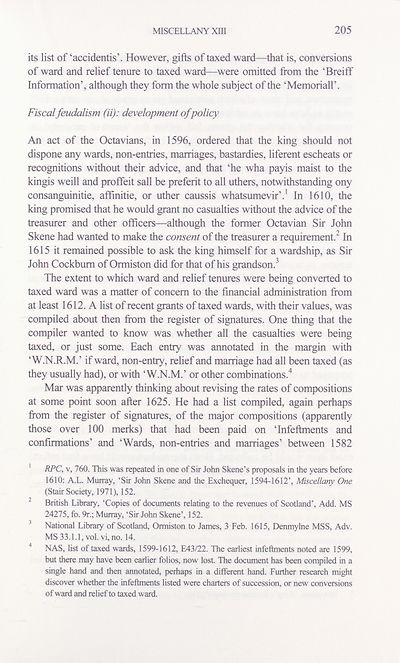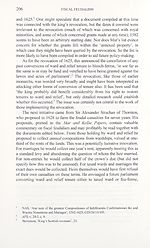Series 5 > Miscellany [of the Scottish History Society] XIII
(220) Page 205
Download files
Complete book:
Individual page:
Thumbnail gallery: Grid view | List view

MISCELLANY XIII
205
its list of ‘accidentis’. However, gifts of taxed ward—that is, conversions
of ward and relief tenure to taxed ward—were omitted from the ‘Breiff
Information’, although they form the whole subject of the ‘MemorialP.
Fiscal feudalism (ii): development of policy
An act of the Octavians, in 1596, ordered that the king should not
dispone any wards, non-entries, marriages, bastardies, liferent escheats or
recognitions without their advice, and that ‘he wha payis maist to the
kingis weill and proffeit sail be preferit to all uthers, notwithstanding ony
consanguinitie, alfinitie, or uther caussis whatsumevir’.1 In 1610, the
king promised that he would grant no casualties without the advice of the
treasurer and other officers—although the former Octavian Sir John
Skene had wanted to make the consent of the treasurer a requirement.2 In
1615 it remained possible to ask the king himself for a wardship, as Sir
John Cockbum of Ormiston did for that of his grandson.3
The extent to which ward and relief tenures were being converted to
taxed ward was a matter of concern to the financial administration from
at least 1612. A list of recent grants of taxed wards, with their values, was
compiled about then from the register of signatures. One thing that the
compiler wanted to know was whether all the casualties were being
taxed, or just some. Each entry was annotated in the margin with
‘W.N.R.M.’ if ward, non-entry, relief and marriage had all been taxed (as
they usually had), or with ‘W.N.M.’ or other combinations.4
Mar was apparently thinking about revising the rates of compositions
at some point soon after 1625. He had a list compiled, again perhaps
from the register of signatures, of the major compositions (apparently
those over 100 merks) that had been paid on ‘Infeftments and
confirmations’ and ‘Wards, non-entries and marriages’ between 1582
1 RPC, v, 760. This was repeated in one of Sir John Skene’s proposals in the years before
1610: A.L. Murray, ‘Sir John Skene and the Exchequer, 1594-1612’, Miscellany One
(Stair Society, 1971), 152.
2 British Library, ‘Copies of documents relating to the revenues of Scotland’, Add. MS
24275, fo. 9r.; Murray, ‘Sir John Skene’, 152.
3 National Library of Scotland, Ormiston to James, 3 Feb. 1615, Denmylne MSS, Adv.
MS 33.1.1, vol. vi, no. 14.
4 NAS, list of taxed wards, 1599-1612, E43/22. The earliest infeftments noted are 1599,
but there may have been earlier folios, now tost. The document has been compiled in a
single hand and then annotated, perhaps in a different hand. Further research might
discover whether the infeftments listed were charters of succession, or new conversions
of ward and relief to taxed ward.
205
its list of ‘accidentis’. However, gifts of taxed ward—that is, conversions
of ward and relief tenure to taxed ward—were omitted from the ‘Breiff
Information’, although they form the whole subject of the ‘MemorialP.
Fiscal feudalism (ii): development of policy
An act of the Octavians, in 1596, ordered that the king should not
dispone any wards, non-entries, marriages, bastardies, liferent escheats or
recognitions without their advice, and that ‘he wha payis maist to the
kingis weill and proffeit sail be preferit to all uthers, notwithstanding ony
consanguinitie, alfinitie, or uther caussis whatsumevir’.1 In 1610, the
king promised that he would grant no casualties without the advice of the
treasurer and other officers—although the former Octavian Sir John
Skene had wanted to make the consent of the treasurer a requirement.2 In
1615 it remained possible to ask the king himself for a wardship, as Sir
John Cockbum of Ormiston did for that of his grandson.3
The extent to which ward and relief tenures were being converted to
taxed ward was a matter of concern to the financial administration from
at least 1612. A list of recent grants of taxed wards, with their values, was
compiled about then from the register of signatures. One thing that the
compiler wanted to know was whether all the casualties were being
taxed, or just some. Each entry was annotated in the margin with
‘W.N.R.M.’ if ward, non-entry, relief and marriage had all been taxed (as
they usually had), or with ‘W.N.M.’ or other combinations.4
Mar was apparently thinking about revising the rates of compositions
at some point soon after 1625. He had a list compiled, again perhaps
from the register of signatures, of the major compositions (apparently
those over 100 merks) that had been paid on ‘Infeftments and
confirmations’ and ‘Wards, non-entries and marriages’ between 1582
1 RPC, v, 760. This was repeated in one of Sir John Skene’s proposals in the years before
1610: A.L. Murray, ‘Sir John Skene and the Exchequer, 1594-1612’, Miscellany One
(Stair Society, 1971), 152.
2 British Library, ‘Copies of documents relating to the revenues of Scotland’, Add. MS
24275, fo. 9r.; Murray, ‘Sir John Skene’, 152.
3 National Library of Scotland, Ormiston to James, 3 Feb. 1615, Denmylne MSS, Adv.
MS 33.1.1, vol. vi, no. 14.
4 NAS, list of taxed wards, 1599-1612, E43/22. The earliest infeftments noted are 1599,
but there may have been earlier folios, now tost. The document has been compiled in a
single hand and then annotated, perhaps in a different hand. Further research might
discover whether the infeftments listed were charters of succession, or new conversions
of ward and relief to taxed ward.
Set display mode to:
![]() Universal Viewer |
Universal Viewer | ![]() Mirador |
Large image | Transcription
Mirador |
Large image | Transcription
Images and transcriptions on this page, including medium image downloads, may be used under the Creative Commons Attribution 4.0 International Licence unless otherwise stated. ![]()
| Scottish History Society volumes > Series 5 > Miscellany [of the Scottish History Society] XIII > (220) Page 205 |
|---|
| Permanent URL | https://digital.nls.uk/127316169 |
|---|
| Description | Over 180 volumes, published by the Scottish History Society, containing original sources on Scotland's history and people. With a wide range of subjects, the books collectively cover all periods from the 12th to 20th centuries, and reflect changing trends in Scottish history. Sources are accompanied by scholarly interpretation, references and bibliographies. Volumes are usually published annually, and more digitised volumes will be added as they become available. |
|---|


